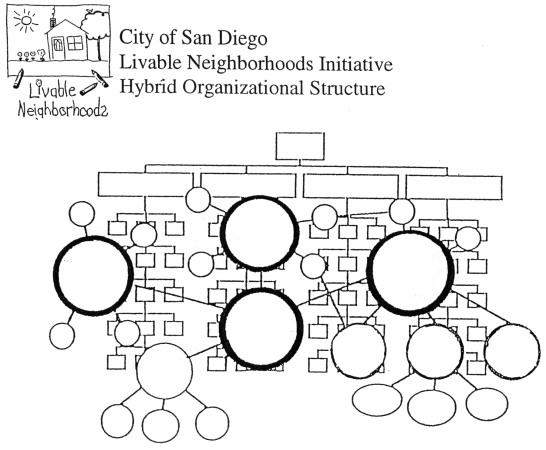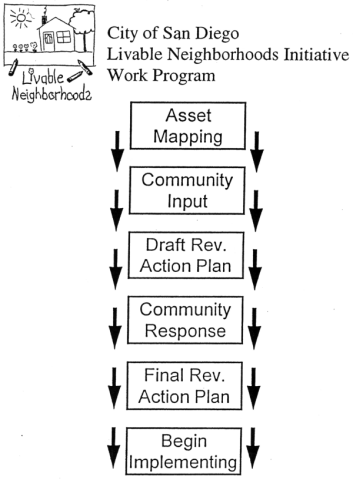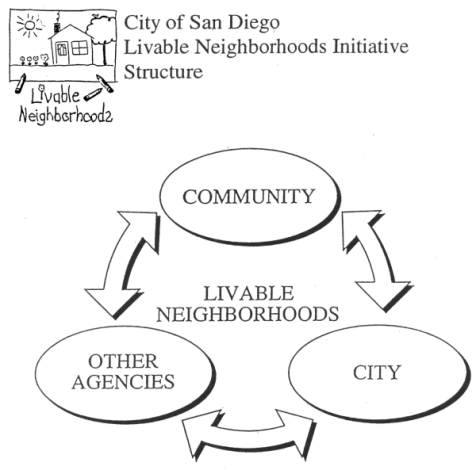

Like many cities, San Diego's urbanized communities are most in need of attention and repair. For too long, the City has let development go unchecked. Residential growth occurred without planning for long term infrastructure needs. Now, many urbanized areas of the City have a decaying housing stock and infrastructure, with inadequate public facilities and services. And since they are predominately built-out, the burden of supplying infrastructure cannot be placed on new development.
Demographic trends have affected San Diego's urbanized areas as well. Many of the urbanized communities have become a temporary home for those who can afford little else. When they get on their feet, they move on, contributing to the transient nature of many urban areas. Also, economic pressures are forcing many families to double and triple-up in housing units, putting even more pressure on crumbling housing and infrastructure. Finally, owners in many of our urbanized communities have moved out, often citing inadequate infrastructure and facilities as the cause. When they cannot rent their units, they often leave them vacant and boarded, further contributing to the decline of our urban areas.
This is not to say that San Diego hasn t been planning. The planning staff has kept busy preparing and updating long-range plans for our communities. Together, these community plans supplement our state-mandated General Plan. The community plans are lengthy documents which outline the land use plan and overall goals and objectives for each community. Where they excel at providing a long range vision, they fail at being able to provide short-term improvements, particularly in the urbanized communities. And, too often, the community plans sit on the shelf after adoption, never
to be proactively implemented, while the planner moves on to work on another community.
To begin crafting the Livable Neighborhoods Initiative, City management agreed
upon the following vision for what makes a neighborhood livable:
It is where people are unified by their appreciation for their neighborhoods' uniqueness. Through partnership, trust and respect, the community is a source of strength and hope for its residents.
With this vision in mind, the management team identified how the City could change to achieve that vision. The team identified the need for comprehensive, but strategic plans to enhance and empower neighborhoods. Other goals included decentralizing public services to be responsive to neighborhood needs and collaboration among public and community resources to create added value.
For each targeted area, interdepartmental teams of city staff were selected to work with the community on revitalizing activities. A team leader, or facilitator, was appointed who was the staff person in charge of the main City program or effort in the community, whether it be a long-range plan, redevelopment plan or park program. Team members were selected from those departments most involved in community revitalization including planning, economic development, police, library, code enforcement, park and recreation, arts and culture, community services, redevelopment, housing, and other departments.
Unlike many previous City teams, the Livable Neighborhoods teams received training to give them the tools necessary to accomplish their objectives. Day-long training sessions covered many topics, such as team building, collaborative planning and conflict management. Perhaps more importantly, the teams were empowered to cut through the traditional City hierarchy, to assemble the resources needed to help do the job. This hybrid organizational structure is illustrated on Figure 4 and shows staff from all levels of the organization working cross-departmentally. This structure was necessary to avoid the red tape that can slow and impede community revitalization.
FIGURE 4: Livable Neighborhoods Initiative, Hybrid Organizational Study

The process for RAP development is tailored to each area but generally includes resource identification, community input, preparing a draft RAP, community response, preparing a final RAP document and implementation (Figure 5). The Livable Neighborhoods Teams begin by creating a resource list which identifies the myriad public and private resources and organizations in effect in a community. These could include capital projects, social programs and even information on community groups. The idea is to catalog every effort going on in a community so that gaps or duplications can easily be identified.
FIGURE 5: Livable Neighborhoods Initiative, Work Program

The second stage of RAP development involves establishing the partnerships that are key to the Livable Neighborhoods approach. Not only do we want internal departments to work together, we want a collaborative effort with community members and other agencies (Figure 6). The Livable Neighborhood teams use their involvement with the community and their resource lists to seek out community partnerships. They then conduct a series of workshops or other public forums with their partners to solicit information on what needs to be fixed in the community. In addition, they address how to fix the problems, what the priorities should be, and the timing, costs and responsibilities associated with each issue.
FIGURE 6: Livable Neighborhoods Initiative, Structure

The information on community priorities is compiled by the Livable Neighborhoods teams and their community partners into a RAP document. The RAPs are short, concise documents which rely on a combination of text and tabular information to present community priorities. The resource lists are also included in the RAPs. Following preparation of the draft RAP, the document is distributed for broad scale review by community stakeholders. A final RAP document is then prepared incorporating any needed changes and the Livable Neighborhoods team, decision makers and other stakeholders then use the priorities to begin implementing projects. The length of time required for preparation of a RAP has varied considerably, and has taken as little as six months.
In addition, the Initiative has also resulted in tangible physical improvements.
The Livable Neighborhoods Initiative has made the City more responsive to its citizenry. Target area community members no longer spend hours on the phone trying to find out who, in what department, can handle their requests. Now, target area community members know who their City team members are and contact them with problems and questions. Team members in turn are extremely responsive to community members. They may handle the request themselves, such as by attending a community meeting to describe the City's Facade Rebate Program. On issues they are not directly involved in, such as in the case of a broken street sign, team members alert the responsible department and follow-up to ensure they are corrected.
The interdisciplinary team nature of Livable Neighborhoods Initiative has also resulted in more knowledgeable staff interacting with the community. Before, it was not uncommon to have two City staff members contradict one another at a community meeting. Now, through the Livable Neighborhoods teams, staff members educate one another about the variety of efforts underway in a community. They are then able to communicate in an accurate and comprehensive manner with residents, business owners and others.
Community members have also received increased attention from the City through the
Livable Neighborhoods Initiative. The Livable Neighborhoods teams regularly hold their team meetings in their communities and attend numerous community meetings to discuss issues with community members. The Livable Neighborhoods teams have facilitated over 100 workshops, neighborhood clean-ups and other events to involve residents in improving their areas. The teams have also co-sponsored approximately 35 other events with local agencies. An example is the Taste of Barrio Logan Restaurant Event which was co-sponsored by the Barrio Logan Livable Neighborhoods Team and raised over $10,000 for a local accelerated educational program. Other examples include the San Ysidro Heritage Day Festival, co-sponsored by the San Ysidro Livable Neighborhoods Team; Traffic Awareness Week, co-sponsored by the Mira Mesa Livable Neighborhoods Team; and, Earth Day, co-sponsored by the Sherman Heights Livable Neighborhoods Team.
The Livable Neighborhoods Initiative also provides increased opportunities for public input. Community members now communicate directly with their team members on neighborhood issues, potential solutions and priorities. In addition, the RAPs also provide the mechanism to capture issues and solutions and succinctly present priorities to decision makers.
A final area that should not be overlooked when addressing how San Diego's Livable Neighborhoods Initiative has benefitted communities is in the area of neighborhood
improvements. With the allocation of community development block grant funding to Livable Neighborhoods in Fiscal Year 1996, each of the initial teams received $17,000 in seed money to provide needed improvements. The teams have used the funding strategically, usually providing small scale grants to match other local funding. The results have been dramatic. In Centre City East, the Livable Neighborhoods team has co-sponsored the Roots Downtown Project which is well on its way to planting 600 trees in Centre City East. In City Heights, the Mid-City team provided funding for a neighborhood tot lot as part of the very successful Alleys Reclaimed by Kids (ARK) project. And the list goes on. The Livable Neighborhoods teams have proven that with
a little money and lots of determination, the City can effectively partner with communities to make critical improvements.
A second complementary effort involves the creation of satellite city halls, called community service centers. At the behest of the Mayor and Council, numerous community service centers are being opened in the City to provide basic City services within walking distance of neighborhood residents. The backbone of these centers will be Livable Neighborhoods teams who will work interactively to improve our City's neighborhoods.
These challenges notwithstanding, The Livable Neighborhoods Initiative has resulted in significant benefits to the City as well as the community. The RAPs provide the action plan for neighborhood improvements. Team members are also better able to perform their core jobs by interacting with each other and community members. Citizens benefit by having identified team members to work with instead of an anonymous City Hall. They also get more assistance form City staff and have gained a stronger voice in what goes on in their communities.
What, then, does San Diego's Livable Neighborhoods Initiative suggest to planners? First of all, planners need to get away from preparing plans that just focus on the long term and on land use to preparing plans that are more comprehensive, encompassing social, economic and cultural issues as well as land use and infrastructure. Comprehensive plans have value in providing the long-term vision for a community. But, we need to supplement comprehensive plans with a strategic planning process that results in identifiable projects that will actually accomplish necessary short and mid-range objectives, whether it's fixing a pothole or building a new library. And, planners should become proactively involved in the monitoring and implementation of our plans. After all, why waste all that knowledge and experience gained during the planning process?
Planners should also work more interactively with other experts. Municipal planners, in particular, should capitalize on the wealth of technical expertise at their disposal in other departments. They should also work to educate other departments of the benefits of working with planners and the need and benefits of working within the framework of a long term vision. Working interactively will help planners do their work and will make others value the planning process.
A final lesson learned from Livable Neighborhoods is that planners, and other staff, must get involved in their communities. Planners should leave their cubicles, talk to community members, business owners, politicians. Participate in community events, street fairs, graffiti paint-outs, everything! Only by getting involved in a community can you begin to plan for it.
Mary P. Wright
Livable Neighborhoods Coordinator
San Diego, California